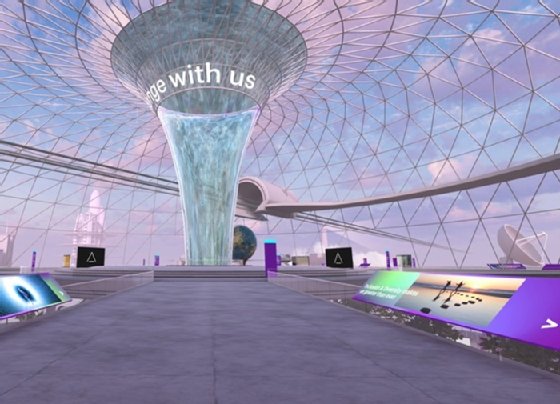
andreaobzerova - stock.adobe.com
Facebook, Microsoft bet on collaborative virtual reality
Microsoft and Facebook think virtual reality collaboration could help companies save on office space and travel. But the tech needs more development to be ready for general use.
Microsoft and Facebook believe the future of collaboration is in a virtual office space where employees meet to regain the sense of presence and camaraderie lost in remote work.
This month, Facebook put its VR collaboration product, Horizon Workrooms, into open beta. The app uses Facebook's Oculus Quest 2 VR headsets to place remote workers into the same virtual space, where they interact via 3D avatars.
In the spring, Microsoft released a preview of its augmented reality (AR) and VR platform, Mesh. Microsoft highlighted the technology's potential for business collaboration, demonstrating how workers might meet to discuss a product design while viewing a full-size 3D model for reference.
Industry observers said it would be years before the technology is refined enough for widespread enterprise use. When it is, though, companies could use virtual collaboration to save money on office real estate and travel, while retaining some of the benefits of meeting in person.
Tech firms are positioning themselves to benefit from an expanding market. Research firm IDC projects AR and VR spending will grow 54% annually, from $12 billion in 2020 to around $73 billion in 2024. IDC believes training and industrial maintenance will drive the growth, with each set to account for $4.1 billion in 2024 spending.
Greg Sullivan, Microsoft's director of mixed reality, said he sees AR and VR as part of tech's continued evolution toward user-friendliness. He cited the switch from the command prompt of MS-DOS to Windows' graphical user interface as an example of that trend.
"That simple transition made computing much more accessible to large numbers of people who were intimidated by the command line," he said, adding that VR and AR represent a similar transition.
Some companies have already taken their first steps into the virtual world, believing its benefits are beyond video conferencing tools like Zoom and Teams. Consulting firm Accenture is one such company. It uses Microsoft's AltspaceVR platform to create the "Nth Floor" -- a simulated office space for training, onboarding new employees and hosting company events.
Jason Warnke, Accenture's digital experience lead, said the company never had a corporate campus and relied heavily on collaboration tools to keep its workforce connected. Indeed, the business bills itself as the largest enterprise user of Microsoft Teams. He said VR seemed like the next step for collaboration; therefore, it made sense for Accenture to experiment with those technologies.
Warnke emphasized VR's use in building company culture and fostering a sense of presence. For example, Accenture has typically held its onboarding sessions in conference centers or hotels, giving new employees a chance to interact with their colleagues in person. When COVID prevented such large gatherings, the company used virtual collaboration to bring new employees together.

"[The VR onboarding] feels like it felt when we could get into a hotel, and there would be the main presenter on stage, but you could chitchat with your neighbor," Warnke said.
Virtual-world vendor Virbela believes the sense of presence and culture-building benefits of VR can provide cost savings for enterprises. Company co-founder Alex Howland cited the example of Virbela's sister company, eXp Realty, which has a Virbela-provided virtual headquarters instead of a physical one.
"Their [eXp's] economic model makes sense because they don't have this fixed brick-and-mortar cost, but they still have this sense of community and culture," he said. "We think it's really important from a cultural standpoint to have that human connection and feel like you're there together."
The technology is not yet ready for the enterprise, however. While employees can access virtual worlds through their desktops, VR and AR headsets provide the most immersive experience. Sullivan said Microsoft is committed to bringing VR and AR to multiple device types, including smartphones and tablets. Still, he acknowledged that the experience would not necessarily be equivalent.
"If you're riding in the back of a rickshaw, it's different from riding in the back of a Rolls-Royce," he said.
Like a Rolls-Royce, VR headsets are expensive. Facebook charges $799 for the enterprise version of its Oculus VR headset, while Microsoft's Hololens 2 starts at $3,500. It's questionable whether businesses will buy the devices on a large scale.
Warnke said Accenture provided headsets to the test groups, but he doesn't believe that will always be the case. He expects costs to come down, and employees will one day use their personal-use headsets to connect securely to the corporate network.
"We're going to probably feel more of the pain upfront than the others behind us," Warnke said of Accenture's early adoption of the technology. "We know we have to do it first, so we can help our clients do it."
Gartner analyst Tuong Nguyen said he expects virtual collaboration to supplement, not replace, other enterprise communications tools like video conferences and chat. In time, employees will pick up a headset and choose to meet in a virtual space when it best suits their needs.
"I feel like these types of experiences are an inevitability," he said. However, he added that they are still years away. "Over time, I think we'll see a more general-purpose, broadly applicable version of VR, but I think we're quite a way off from that."
Forrester Research analyst J.P. Gownder said tech companies want their collaboration tools to seem more realistic than the video squares of Zoom, Teams and Webex.
"Some of [the companies] will fail, but it is the flowering of experimentation and creativity that will lead to success at some point," he said. "The reason that I'm a believer is that I think a naturalistic interaction model is necessary for a world that will likely be permanently less office-focused."
Mike Gleason is a reporter covering unified communications and collaboration tools. He previously covered communities in the MetroWest region of Massachusetts for the Milford Daily News, Walpole Times, Sharon Advocate and Medfield Press. He has also worked for newspapers in central Massachusetts and southwestern Vermont and served as a local editor for Patch. He can be found on Twitter at @MGleason_TT.








